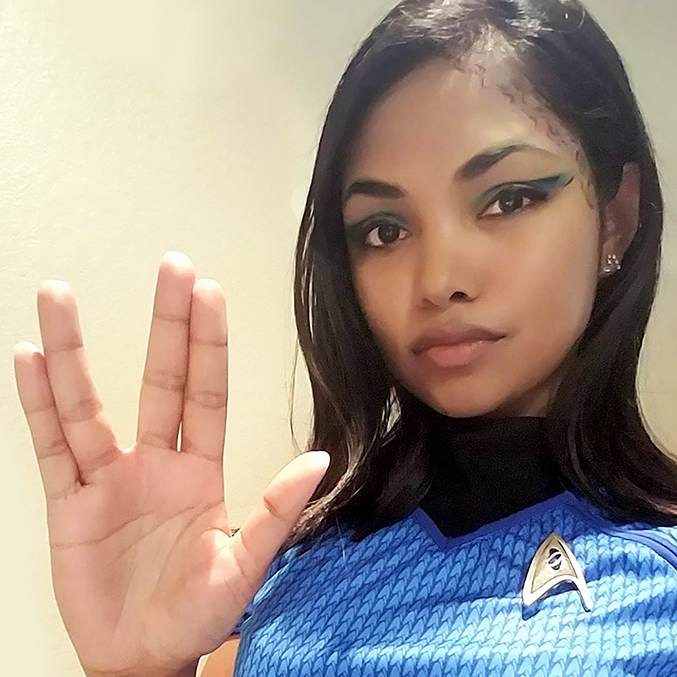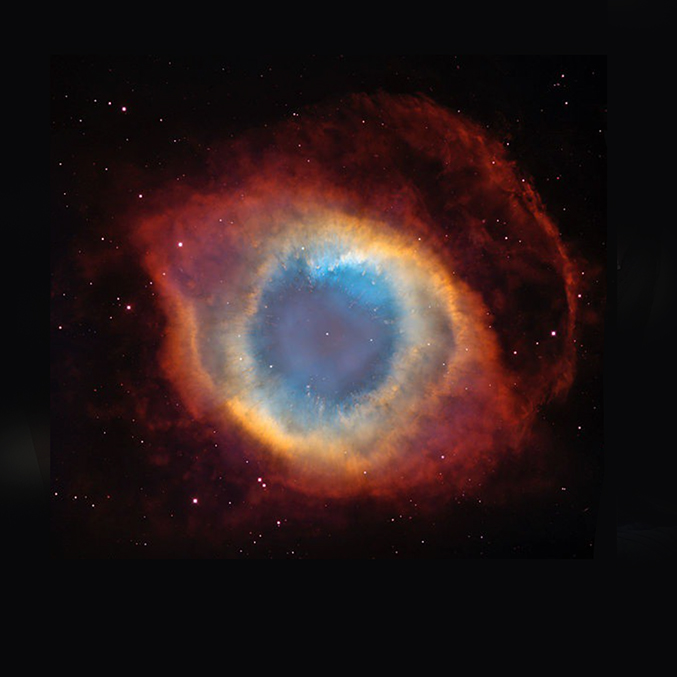
Lisa Marie Persaud with her painting, A COSMIC PERSPECTIVE
Cosmic Sister Emerging Voices Award winner Lisa Marie Persaud (@lmariepersaud) and I share a devotion to the great uncharted wilderness within and without—uncharted psychescapes and outer space. We are among the many journeyers who experience flying through space during psychedelic visionary states.
Lisa Marie—who describes herself as an artist and “student of philosophy, psychology, and cosmology helping people get in better touch with themselves and the more-than-human world”—posted this mind-bending photograph that reminds her of an especially magnificent, healing trip in which she saw shooting stars while floating in front of the God’s Eye Nebula. The immensity of love and beauty she experienced moved her to tears.

Garden of Galaxies, NASA Hubble space telescope, known as the Ultra-Deep Field
She shared this entry from her trip journal:
“Among this garden of galaxies, there is no second Earth. What an immense privilege it is to be here, and how important that we tend to the needs of this beautiful, rare, and life-giving, organism!
This snapshot taken by the NASA Hubble space telescope, known as the Ultra-Deep Field, is a portrait of our shared past and features some 10,000 galaxies—some of which were birthed when the universe was just 800 million years old. It is a picture of our galactic ancestors and of our infancy; an invitation to explore and discover a bit more about the grand mystery we find ourselves a part of.
This beautiful image represents just one tiny corner of our visible universe. It shows us we exist because of billions of years of simple and complex processes. Such vastness also helps us to comprehend just how fortunate we are.
As the world without calls to us, so too does the world within. Psychedelics are telescopes that reveal the invisible landscapes of the mind. The two tools together unveil hidden dimensions and the dynamic imagination of nature. We find, in the darkness of sky and mind, immense light and love. Both Hubble and psychedelics are doors of perception, illuminating worlds unknown and forgotten—worlds that have much to teach us and are greatly needed during this time of transformation.
Lisa Marie describes one awe-filled trip on LSD, sitting in the dark, as the vivid colors of the God's Eye nebula surrounded her. “I could see shooting stars traveling long distances, piercing through the nebulous veil and my body... the nebula, emitting love and light, enfolded my soul until the distance between us collapsed and I felt Nature—whole.”
Lisa Marie is pursuing a Master of Science in Education in Counseling and Mental Health Services at the University of Pennsylvania. “I would love to work with people at NASA, SpaceX, Blue Origin, or Virgin Galactic, especially those launching into low orbit, and those aboard the ISS,” she says, though she hasn’t found many opportunities related to counseling or coaching.
“It’s extraordinarily important that—as we send more people into space—we view inner work, and integration of that work, as essential,” she adds. “I hope that, with the rise of commercial space flight, I can help to cultivate the space counselor role. Integration therapists are needed in both renaissances—psychedelic and human space flight.”
Did you grow up watching Star Trek?
I first became aware of Star Trek: The Next Generation when I was 8 years old. It was one of my grandfather’s favorite shows, and we were incredibly close, so I would often sit by him when it came on, and we’d watch it together.
I recall being fascinated by the diversity of life forms that the crew of the Enterprise would encounter. The thought of space travel and meeting intelligent life beyond Earth was exciting and stirred my imagination. After my grandfather passed away, however, I stopped watching TNG—I was 10 years old at the time. In my mid-to-late 20s, I began watching the original series, revisited TNG, and have seen every Star Trek episode since. The show’s message on the importance of understanding, of embracing each other and getting to know one another… and taking the courage to boldly go where no one has gone before… continues to resonate with me.
When you look up at the stars, do you ever think about if someone else is looking out at us?
Oh yes! And I have been wondering if there are intelligent life forms out there ever since I can remember. When I was about 4.5 years old, I had a deeply spiritual experience—I saw, against the black of night, from the windows of my grandparent’s house in Guyana, this beautiful and colorfully lit float drifting down the lonely dirt road aside our house. This spectacularly lit float was decorated in celebration of Diwali (the festival of lights) and symbolizes the illumination of one’s path back home and the triumph of good over evil. I recall watching the float drift by until it was completely hidden from view—I had never seen anything so magnificent before. Staring into the dark, I felt an intense calling to look up at the night sky and was left awestruck. The stars were incredibly bright and beautiful, and some were quite colorful, just like the lights on the float. I couldn’t take my eyes off of the sky and felt intensely that I came from the stars.
Shortly after this experience, I moved to the United States, and I recall encountering the show ALF. I loved ALF, short for Alien Life Form. He was an extraterrestrial, loved pizza, and was obsessed with cats. I resonated with ALF, continued to wonder about life elsewhere, and hoped that someday I would be visited. I still wonder if there are lifeforms beyond our own out there, especially intelligent lifeforms from advanced civilizations. If there are advanced civilizations out there, and we are lucky enough to discover and meet them, I wonder what we’d learn. An encounter with an extraterrestrial intelligent species has the ability to throw everything we think we know into revision-- it would broaden our understanding of nature and existence, help us to change our minds, and I think, help to unify us.
As I got older and encountered Carl Sagan and the film Contact (1997), I became aware of NASA’s SETI program (unified by the search for, and understanding of, life beyond Earth), and later their partnership with METI (an interdisciplinary endeavor to conduct scientific research, education outreach, and design interstellar messages for transmission to nearby star systems), and was completely taken by the fact that there are astronomers, and scholars of every kind, out there exploring outer space—this expanded my horizon; the search was happening, and this wowed me.
If you were leading an initiative for space counselor training, what are some of the things you would put at the top of the list?
Compassion, patience, curiosity, and the courage to seek to understand would all be at the top of the list—and I think this nicely circles us back to Star Trek; we need to be bold and allow for the risks that accompany being open and vulnerable. This is how we discover worlds unknown.
An open heart allows for compassion, empathy, and understanding—without openness to experience, we withdraw in fear. Kindness and respect for all identities and forms of nature would also be on the list—this comes with understanding our shared cosmic history and how interconnected, interrelated, and interdependent everything is. Deep breathing exercises, mediation, mindfulness, ecotherapy, group work, and other exercises that lend to social emotional learning would also be on the list.
And no training is complete without an orientation to the Overview Effect (a term coined by Frank White in 1987), listening to astronauts talk about their experiences in space, what it has taught them, and how it has influenced their behaviors upon returning to Earth offers us a new perspective. Astronauts who’ve experienced the Overview Effect commonly feel like they are discovering the Earth for the very first time—seeing the planet whole, in all its splendor, and acknowledging its rarity helps us better recognize and understand our unique responsibility to the rest of life, including the planet herself. The message is best encapsulated by the words of Dr. Martin Luther King Jr., who said that we “are caught in an inescapable network of mutuality, tied in a single garment of destiny. Whatever affects one directly, affects all indirectly.”
If you could bring one book with you on a space journey, what would it be and why?
This is a tough question! At this moment, I would take Joseph Campbell’s The Hero with A Thousand Faces. This book is beautiful and introduces you to various ways of perceiving, experiencing, interpreting, and being. It contains the stories of mythic heroes from all corners of the world, and it speaks to the adventurer in us all. It is rich in exploration, giving to insight, and reminds us of the elegant symbols or threads that reoccur and serve to unify us all. It also includes the iconic photograph known as Earthrise that catalyzed the environmental movement.
If you could create your own role on Star Trek, what would your character be like?
I would be a Vulcan-Human-Trill, hosting the symbiont Dax, in the role of ship’s counselor. Symbionts are creatures that live many lifetimes and share in a symbiotic relationship with their host. Their lived experiences, coupled with the breadth and complexity of human emotions and Vulcan telepathic capabilities make for a fascinating character. It would be a dream come true to be on Star Trek (Picard or Discovery).
Which psychedelics have you worked with?
My first successful psychedelic experience was with Salvia divinorum—I say “first successful” because I had utilized Amanita muscaria but didn’t have a visionary experience, just elated emotions. I’ve experienced magical, challenging, and important encounters with Psilocybe cubensis and LSD, gifted to me by a dear friend on my 27th birthday.
One Salvia divinorum experience lasted a minute or less, but during that time, I was catapulted into a fantastic cartoon world, placed on [Albert] Hofmann's bicycle and led down a yellow brick road. All along, on both sides of the road, vibrant, gorgeous flowers smiled and cheered me on. The beauty of it all made me erupt into laughter—so much laughter that I wound up crying. I felt a wave of love and was profoundly moved, astounded that such a happening could even occur. A sense of being on my way, wherever the road led, filled me with great hope. The experience, which might have been magnified by an extremely challenging relationship I was in at the time, was a much-needed reminder that what I was dealing with was part of my journey but not at all a final destination. It was, and remains, a significant and healing experience.
Has your personal work with psychedelics in any way influenced your choice of career from a perspective of outer space and space travel?
I find psychedelic experiences to be fascinating—and not dissimilar to space exploration. There are risks involved in both adventures, and each experience is novel and lends to ruptures in our existing schemas; in that rupture lies the potential to encounter something new about ourselves, about each other, and about the universe, and this can fundamentally shift the way we perceive and relate to nature. Both space exploration and psychedelics have given direction to my interests and talents and lent to the process of self-discovery.
The inner and outer landscapes are interconnected, interrelated, and interdependent—and the discoveries that can be had in each of these realms require us to venture out of our comfort zones and into unmapped dimensions to achieve a better understanding of what it is we’re a part of.
Reflecting a bit further on the parallels between space exploration and psychedelics, Star Trek: Discovery’s Paul Stamets, played by Anthony Rapp, is an astromycologist inspired by real-life mycologist Paul Stamets. I love their incorporation of the mycelial network into the show as an intergalactic web and ecosystem containing infinite, and discrete, pathways throughout space—it reminds me of the global brain connectivity witnessed under psilocybin, the neuronal network itself, the psychic worlds encountered during psychedelic experiences, and the supercluster we find ourselves in, Laniakea.
Do any visionary experiences come to mind?
One summer, about eight years ago, I was invited by a friend to join a group of folks on a weekend getaway to a cabin in a gorgeous, wooded area in Pennsylvania—a cannabis brownie was involved. On the first night, a large grasshopper was heard making chirping sounds; everyone was headed to bed, and one of the group members sought to kill it. I spotted the grasshopper and quickly cupped it with both hands to save it from being crushed.
When I opened my cupped hands, I saw this beautiful and fragile green creature that slowly began to maneuver its head towards mine—our eyes connected and everything in sight, all else beyond myself and this creature, dissolved. Time dissolved—I felt infinity in the eyes of this grasshopper and experienced the merging of our forms. The entire happening occurred within a span of a couple of minutes. I quickly let the grasshopper go into the woods and returned to the cabin, astonished. It was an encounter with spirit, and I felt deeply honored to behold such a magnificent creature. I felt a deep reverence for forms beyond my own but also great sadness at the thought that someone intended to harm the fragile creature.
This spiritual experience cracked my worldview because I was interfacing with—not projecting onto—the grasshopper and saw myself and this grasshopper in a sort of cosmic dance. There really aren’t words to accurately describe the immensity of rejoicing that I felt.
This communion, among many other beautiful experiences with the more-than-human, taught me that all forms of nature are interconnected, interrelated, and interdependent—each subject is indeed, a song of the universe.
How can psychedelics help us evolve ethically?
Psychedelics are an invitation to see things differently—literally. Our senses receive and our organs process data in alternative ways than what we’re used to. Those of us familiar with psychedelics have seen those iconic figures showing global brain connectivity and visual destructuralization, oceanic boundlessness, and anxious ego-dissolution. Many, who’ve engaged with psychedelics, myself included, have experienced “oceanic” feelings. The oceanic experience is powerful and, very much like the Overview Effect, allows us to recognize just how multi-dimensional consciousness is, how mysterious nature is, and how intricately interwoven, interrelated, and interdependent all is on all else. When we begin to realize how interconnected we are with the rest of life, we understand how fragile we are as a species… and how precious life is. The experiences, perspectives, and broadened sense of openness that psychedelics offer us allow for greater empathy in our relationships with both humans and non-humans. One experience commonly cited in psychedelic experiences is encountering Earth as a living being, and just as the astronauts return from space feeling an immense responsibility to cherish and protect it, so too do psychonauts. The message is remarkably identical—we are all interconnected and responsible for the reduction of unnecessary suffering. As Martin Luther King Jr. said, “Whatever affects one directly, affects all indirectly.” These encounters, and messages, no doubt, inform our ethics and help us evolve as a species.
Do you think humans are ready to go out into space?
I don’t know if we’ll ever be “ready” or fully prepared for space exploration or what we may discover and encounter out there, but I do know that we must engage in it. If Earth is the only planet known to sustain life in the entire universe, we have an enormous responsibility to ensure that that life thrives as long as time affords it.
And even if it turns out that we cannot thrive on other planets within our solar system, being able to see the Earth from space can transform the way we relate and interact with it. It is paradigm shifting. Recognizing that we are part of nature is incredibly important, and so, too, is the installation of hope—like that experienced during the Apollo 11 moon landing in 1969. Our time desperately calls for hope and a radical re-imagining of our social, political, and economic infrastructure, and space exploration can help us evolve to meet these needs by allowing us to see more clearly.
We’ve gained so much from space exploration. It is through our exploration of Venus that we learned about Earth’s ozone hole and what was contributing to it (CFCs). If we do, one day, achieve a human presence on Mars, it will require a new society—one that will need to learn how to trust and rely on each other for survival. Space exploration presents unique challenges that will help us bring forth new possibilities and ways of being. In going to Mars, we will learn more about ourselves, gain a new appreciation for life, and re-discover Earth.
Do you have concerns about the colonization of space?
Yes, I do worry about the colonization of space, a lot—engaging in space exploration as a divided species and without a global contract for peaceful, respectful, and non-maleficent relations is a mistake. Language is also very important—we need a new vocabulary for space exploration; we cannot continue to use words such as “colonize” that embed racial traumas. I worry about the lack of access and marginalization of peoples based on race, ethnicity, sexual identity, geographical location, religious identities, and socio-economic and political statuses, etc. I am really awed by the work of Timiebi Aganaba, who has made strides in raising awareness about these important issues. She has an incredible TEDx talk, “The Future of the Space 4.0 Era,” which everyone should check out. I also love Blue Marble Space’s “One Flag in Space” initiative that promotes the use of the iconic “Blue Marble” photo as the symbol for international unity and advocates for its use in all future space missions.
Another thing I worry about is our definition of life and categorization of sentience. Our definitions are limited, and this structures how we engage with the worlds within our reach. How we would relate to something that we’ve never encountered before is a big question given the assumptions we currently hold; there is also great potential to miss signs of life and techno signatures based on those assumptions.
On a positive note, the 1967 Outer Space Treaty was signed by 111 countries and prohibits the use of nuclear weapons in space, as well as the establishment of military bases, and states that the use of space is for peaceful purposes. There is, however, much work to do to ensure that space exploration is indeed a peaceful endeavor and inclusive of all. We’ve yet to cultivate sound principles that will guide us in our exploration of space.
The Earth Charter of 1987, with the guiding principles of “respect and care for the community of life, ecological integrity, social and economic justice, and democracy, non-violence, and peace,” and the UN’s Space4SDGs propose some ideals that we are striving for but still struggle to implement because of our lack of courage to engage in experimentation in the service of our present needs and future. As Carl Sagan poignantly stated in his book The Cosmic Connection (1973), we need to undergo radical “mutations” and be supportive of “social, economic, and political experimentation” globally, if we are to achieve these goals.
I love the First Contact photo of you so much!
I took this photo in celebration of the 1996 Star Trek film First Contact. The film depicts the first meeting between Earthlings and an extraterrestrial intelligent species, the Vulcans. In the film, on April 5, 2063, Zefram Cochrane becomes the first human to travel at warp-speed, giving rise to the United Federation of Planets, Starfleet, and the peaceful exploration of strange new worlds. First Contact shows us what a peaceful encounter could look like and is a day I’ve been dreaming about since I was a child. “Live long and prosper” is also a beautiful greeting, symbolic of understanding, love, hope, and peace.

Lisa Marie Persaud, First Contact

God's Eye or Helix Nebula. Image credit: NASA, NOAO, ESA, the Hubble Helix Nebula Team, M. Meixner (STScI), and T.A. Rector (NRAO)

A Cosmic Perspective, a painting by Lisa Marie Persaud
